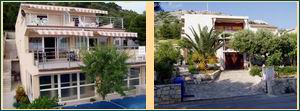

In the central part of croatian Adriatic Sea, about 15 Nm to the west from Sibenik town, 7 Nm to the southwest from Murter, or 15 Nm to the south from Zadar town, there is amazing group of islands named Kornati archipelago.
Beauty and singularity of the archipelago moved authorities in 1980 to proclaim a bigger part of that area national park. Since then certain modifications of its borders were made, so that nowadays Kornati National Park occupies the area of about 220 km2 (54.000 acres). There are 89 islands, islets and reefs within the area of Kornati National Park (238 km of the coastline), what makes it the most indented group of islands in the Mediterranean.
The land part of Kornati National Park covers less than 1/4 of its total area, but the values of its landscapes, the "crowns" (cliffs) on the islands facing the open sea, and interesting relief structures, make this part of Kornati National Park unique. Besides, the Kornati submarine area, whose biocenosis are considered to be the richest in the Adriatic Sea, and also the magnificent geomorphology of the sea bed attracts divers from all over Europe to come and enjoy in unforgettable submarine adventures.
The Krka National Park is a spacious, largely unchanged region of exceptional and multifaceted natural value, and includes one or more preserved or insignificantly altered ecosystems. It is intended primarily for scientific, cultural, educational, recreational, and tourism activities such as visiting and sightseeing. It was proclaimed a national park in 1985 and is the seventh national park in Croatia.
The Krka National Park is located entirely within the territory of Šibnik- Knin County and encompasses an area of 109 square kilometers along the Krka River: two kilometers downriver from Knin to Skradin and the lower part of the Čikola River. From the flooded part of the mouth, it is 72.5 kilometers in length, making the Krka the 22nd longest river in Croatia.
The source of the Krka River is at the base of the Dinaric Mountains, 3.5 kilometers northeast of the base of Knin and 22 meters below Topoljski Slap, Veliki Buk and Krčić Slap, which are noisy cascades in the winter but run dry during the summer.
The length of the freshwater section of the river is 49 kilometers and that of the brackish section is 23.5 kilometers. Significant tributaries of the Krka River include Krčić, Kosovčica, Orašnica, Butišnica and Čikola with Vrb. With its seven travertine waterfalls and a total drop of 242 meters, the Krka River is a natural and karstic phenomenon.
Vransko lake (in the past Vedro blato) distanced only 13 km from Murter island, 10 km from Pašman island and 30 km from Ugljan island. An example of cryptodepresion - the lake bed is underneath the sea level and the lake surface is over the sea level. The surface of this salt lake rich with fish is 30,15 km2. The water flows down steep cliffs and in the 18th century (1752-1770) dug out channel Prosirka in to the Pirovac bay.
By the north-eastern shore, dense with trees, rises the highest peak of Ravnih Kotara - Štandarac (305m) from witch stretches a beautiful view of the coast and the sea. The average temperature in January is 6,8 degrees, and in summer 25,1 degrees. Since 1983. part of the lake is an ornithology reserve (habitat for a 110 species of birds), and from October 1999. the whole lake is a nature park.
The waters flowing over the limestone and chalk have, over thousands of years, deposited travertine barriers, creating natural dams which in turn have created a series of beautiful lakes, caves and waterfalls. These geological processes continue today. The forests in the park are home to bears, wolves and many rare bird species.
With its surface area of 96 km2, from the eastern coast of the Adriatic Sea to the highest peaks of the Velebit Mountains, Vaganski Vrh (1757 m) and Sveto Brdo (1753 m), Paklenica abounds with numerous natural wonders and phenomena, which is why the entire area was proclaimed a national park in 1949. And rightfully so, as this region is simple and unusual in its connection between the sea and the mountains, rich in beech and black pine forests, its deep canyons cut vertically into the Velebit ridge, its karst formations and numerous caves and pits.